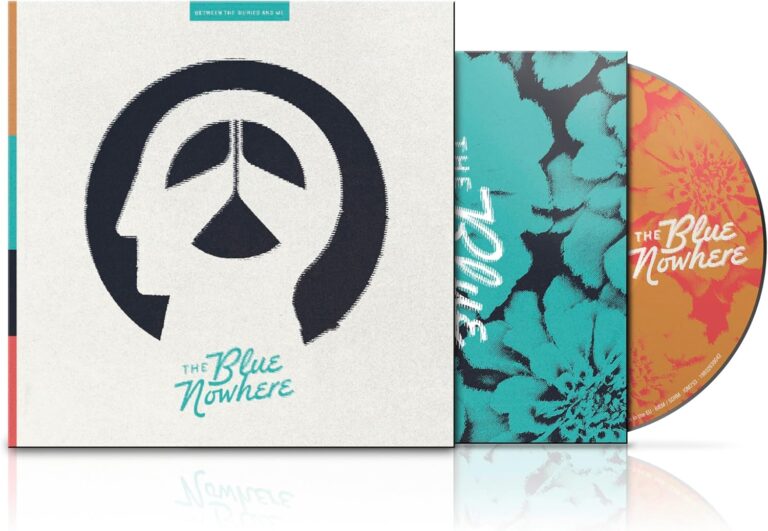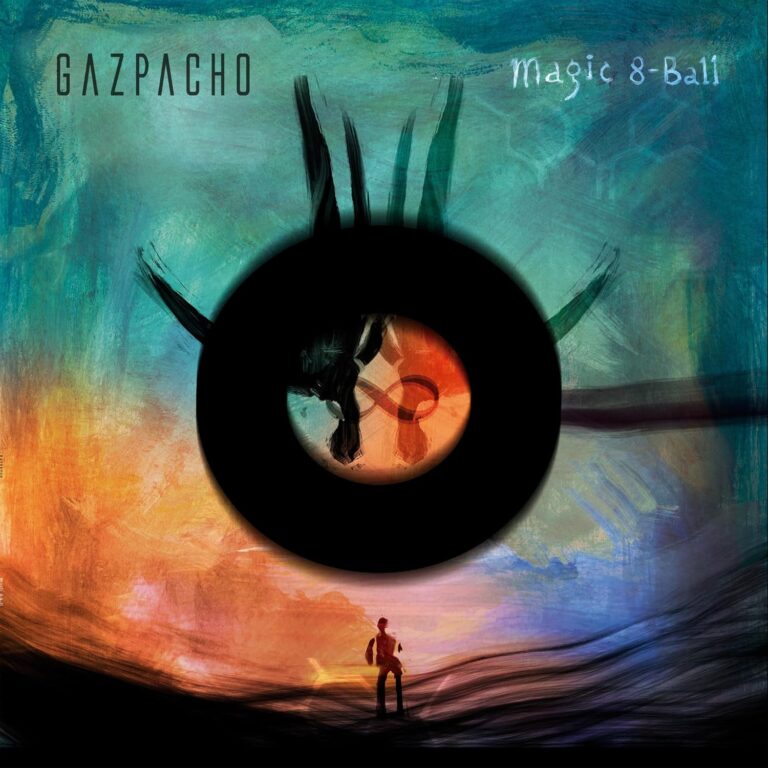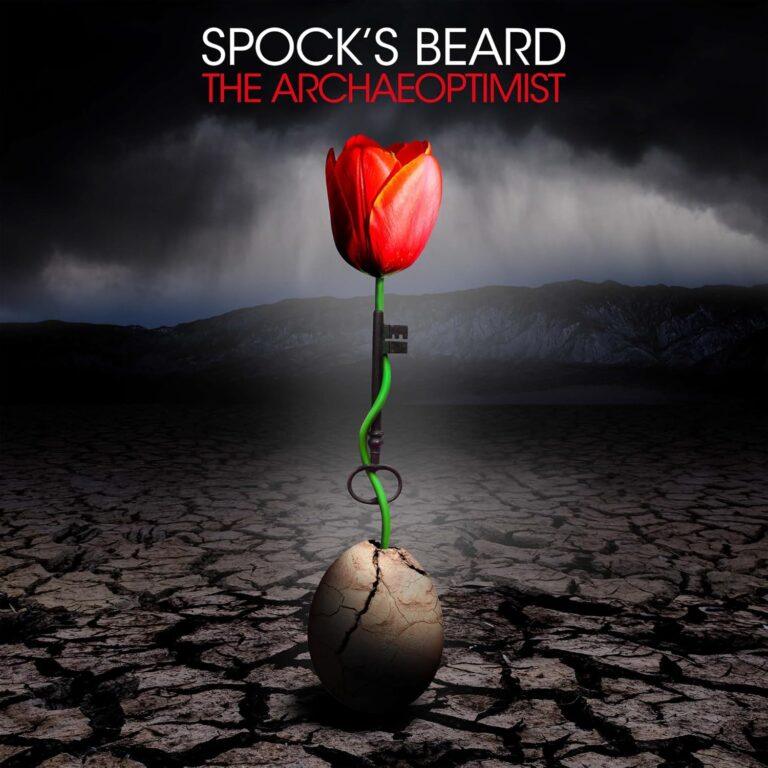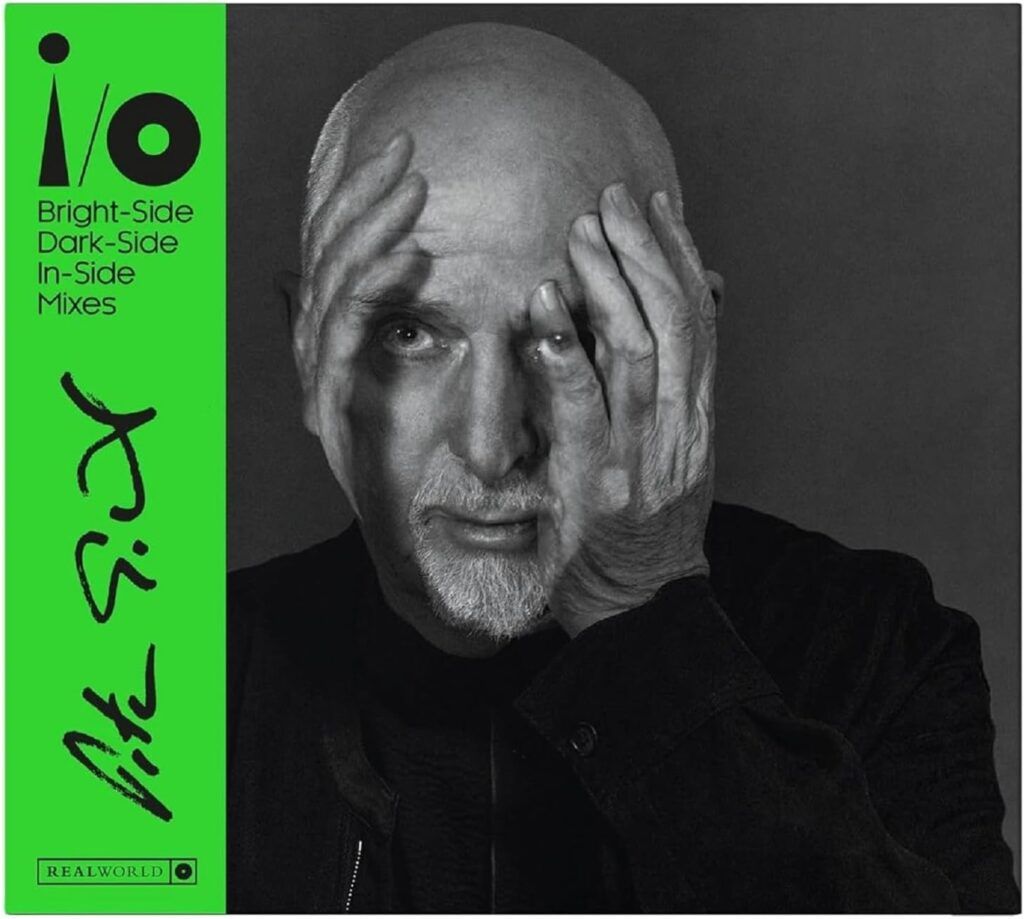
Introduction
Superficially, at least, it could be argued that Peter Gabriel and his former band, Genesis, charted very similar courses upon their seperation, with both acts achieving remarkable mainstream appeal during the late 80s and early 90s, seemingly in spite of themselves. However, while Peter retained a certain credibility, despite the rampant success of tracks like Sledgehammer and Steam, Genesis fared less well. Dig beneath the surface of the music, however and the reasons become more obvious. While Genesis could still ‘do’ prog when the mood took them (as the sweeping Driving The Last Spike demonstrated), their take on driving pop was far more simplistic, stripping away the complexity of their early years to reveal a rather ruthless ambition. Peter, on the other hand, was rather more subversive, innovating by stealth and, despite the hit singles with which his albums were peppered, the mega-selling So and Us explored a range of soundscapes ranging from haunting mood pieces (Red Rain), to abrasive art rock, even veering into industrial territory on the likes of Digging In The Dirt, helping him to maintain his status as a forward-thinking artist at a time when any number of acts who had peaked commercially during the 80s were being swept away.
Progress came at a cost, however, with Peter adopting an increasingly leisurely place to writing. From So to Us, fans endured a six year wait. From Us to Up, the gap extended to ten years (albeit with OVO and Long Walk Home appearing in between), while from Up to I/O the wait has been an astonishing twenty-one years, with only an orchestral reworking of various songs and a rather odd covers collection emerging in the interim. The album itself, of course, has been teased over the course of a full year, with Peter indulging “full moon releases”, starting back in the January. Nevertheless, for those wanting to hear the album in full, it has been a long, if worthwhile wait. And so, with the album finally here, we can see that Peter has lost none of his melodic nous, nor his ability to surprise. Indeed, I/O not only demonstrates Peter’s uncanny knack of adopting modern elements, but it never once sounds like anything other than him in the process, creating the rather odd sense that he’s never been away.
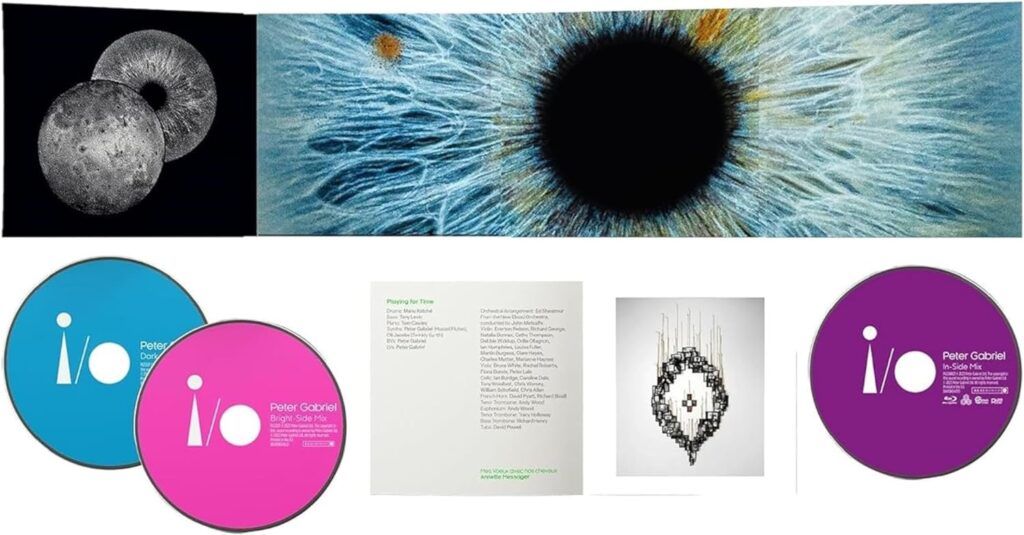
The Package
Released in a range of formats, I/O can be purchased as both a 2-disc set, featuring Tchad Blake’s Dark-Side mix and Mark ‘Spike’ Stent’s Light-Side mix; and a 3-disc edition, which adds Hans Martin Buff’s In-Side Mix (Dolby Atmos) on blu ray. You can also buy each mix on double vinyl separately, while a box set gathering everything together is promised in March of next year. This review covers the 3-disc effort, which features Dark-Side, Light-Side and In-Side mixes. The primary review covers the Dark Side version, with additional notes for the Light Side and In-Side mixes.
Album Review (Dark-Side Mix)
Opening track Panopticom nods to the past, with Peter’s oh-so-familiar vocal paving the way for a multifaceted piece that moves deftly from the dark electronica of its first verse, through an airy, acoustic pre-chorus, into a hard rock chorus that packs a hefty punch. As we’ve come to expect from Peter, it’s beautifully produced, with Tchad Blake giving the music a darkly muted sheen – like a piece of brushed metal – that gives focus to synths and programming of Peter and Oli Blake. Manu Katche’s polyrhythms provide the backdrop for The Court, although the electronic elements remain, sitting comfortably alongside Tony Levin’s probing bass and a stunning orchestral arrangement, given greater weight for being the real thing and not a plug in. A haunting track, The Court showcases Peter’s ability to straddle the world of contemporary music production and the progressive / art world where he made his name, and it flows beautifully. In contrast, Playing For Time is a heart-breaking piece that builds from poignant introduction, supported primarily by orchestra, to a cloud busting finale that deftly brings all the elements together for a soaring conclusion possessed of real emotional weight. Less successful is I/O, which offers whimsical lyrics set to a musical backdrop drawn straight from So, with perhaps a touch of Downside Up thrown in for good measure. That said, its chorus will still lodge itself firmly in your brain, but it remains a weaker track on the album overall. More interesting are the subtle, trip hop elements of Four Kinds Of Horses, which mixes eighties chic and modern electronica to impressive effect. This is where Peter is at his best, referencing his history, but with a restless and inquisitive spirit that sees him seek out new technology with which to expand his vision. Then there’s the ecstatic, strutting funk-rock of Road To Joy, which sits somewhere between Sledgehammer and Steam, only with added strings and a dad-dance twinkle in its eye that shows Peter and his band still know how to have fun.
Opening the second half, the piano-led So Much strips away the massed banks of instrumentation to leave Peter alone with his thoughts, and it’s all the more effective for a subtlety that, perhaps surprisingly, nods to Roger Waters and The Wall, particularly in the gentle swell of brass and choral harmonies that emerge towards the end. Next, the gleaming melody of Salisbury Hill is given a cheeky, millennial make over with Olive Tree, a pulsing track, complete with a typical Gabriel lyric using nature as an allegory, that builds to a gleaming, brass-soaked chorus. A joyous moment, Olive Tree is a fun song and something of an album highlight. Neatly contrasting with it, the slow-paced Love Can Heal develops at a leisurely pace, the gorgeous refrain left to backing vocalists Rioghnach Connolly, Melanie Gabriel, Jennie Abrahamson, Linnea Olsson, and Faye Dolle, who give the piece an ethereal quality. With its simple sentiment, This Is Home is a heartfelt piece, that drifts a little too firmly into the sonic territory of So, to the extent that it could slot neatly onto that album, and it lacks the expansive vision of other tracks found here. As such, the hazy And Still is the better song, Peter working with Richard Chappell to create a dreamy electronic backdrop, although the ever-present Tony Levin remains to anchor the piece. It simply sounds stunning, especially when a violin penetrates the mix, and the track offers a sweeping conclusion that thrills the senses. The album concludes with the vibrant Live And Let Live, which feels like a natural endpoint, drawing on a range of influences form the electronic to the organic and delivering a deeply satisfying finale to an album that seems to envelop the listener from start to finish.
I/O is very much a Peter Gabriel album, existing in the same sonic realm as So, Us and Up, meaning that the songs on offer capture the attention with surface level melodies, only to gain significantly more weight on repeated listens. As with previous outings, it boasts a simply astonishing production that, even in humble stereo, seems to wrap itself around the listener, whichever mix you favour. However, what marks this album out is the way that each of the supporting cast of musicians seems to be overjoyed to be a part of Peter’s journey. There’s a light and life to the majority of the performances that is irresistible and, while not every track sticks the landing, the album as a whole feels like a summation of a wonderful career. Who knows how long we’ll have to wait for the next Peter Gabriel release but, for now, I/O feels like a gift. 8/10
Mix Notes:
Light Side Mix
How different can two mixes be? Well, it turns out quite different, with Mark ‘Spike’ Stent’s Light Side mix offering a very different sense of dynamics. While the elements found in the dark-side mix are largely still there, they’ve been neatly shuffled to place the focus on the organic instrumentation rather than the electronics, leading to a much airier sound, as the name implies. As a result, tracks like Panopticom, The Court, and the title track all sound quite different, The Court gaining a stronger emphasis on Manu’s excellent percussion and allowing more space for the piano parts to breathe in the latter half, while Four Kinds Of Horses is a very different beast altogether, sounding more artrock than triphiop in this incarnation.
Inevitably, it’s the tracks with a more complex backdrop that change the most, while pieces with more subtle arrangements, such as Playing For Time, remain fairly similar, leaving rather less room for interpretation, although Tony Levin’s subtle jazz influences arguably cut through the mix in that track a touch more.
In offering two separate mixes, Peter Gabriel has allowed a glimpse of two alternate realities. In very broad terms, the dark-side mix offers more to those who prefer a darker, slightly more electronic sound (not dissimilar to the darker edges of Up), while the light-side mix is rather more organic (in the vein of So), with both mixes having their relative charms.
In-Side Mix
Here’s where things get really interesting, because Peter Gabriel already offers some of the most detailed and spacious production in contemporary music. As such, his work is custom made for surround sound, and I/Odoes not disappoint. Created as a unique mix, In-Side sees Hans Martin Bluff creating a genuinely immersive surround mix that folds itself around the listener in a manner that few such options actually do. It should be noted also that, although it is a Dolby Atmos mix, it folds down beautifully to 5.1, meaning that those with older setups do not lose out.
It takes only a few moments of opening song Panopticom to realise the immense achievement of the In-Side mix. Where the format was once abused by studios churning out cheap stereo upmixes (Silverline were particularly pernicious in this regard), the work done here is astonishing and, as Peter’s backing vocals, along with subtle splashes of synth, bleed from the rears, so you find yourself within a living, breathing soundscape. It gets better, too, with the remarkable percussion of The Court expanding an already impressive song and presenting it from an entirely different angle. Truly, there are few surround options to match it – Steven Wilson’s remarkable work on Fear Of A Blank Planet and The Incident are up there, as are the mixes done for The Flaming Lips, who enthusiastically adopted the technology of DVD-A for a range of albums and EPs – and to hear it in this format is to gain a whole new level of appreciation for the astonishing detail hidden within the mix. Even the simpler songs, like the beautiful Playing For Time, gain a new level, with the orchestra allowed to slowly spread out across the soundstage until it reaches its remarkably cinematic conclusion, the music soaring beautifully before it drops back into stereo for its poignant coda. I/O is similarly dynamic, with the pared-back verse held firmly in check in the front speakers, with only a touch of ambience allowed to spread out, only for the chorus to explode into the third dimension. However, it is the songs with stronger elements of electronica that really benefit from this treatment, and Four Kinds Of Horses, which has both strings and synth elements, really makes use of the additional channels on offer.
Strangely, only the funky strut of Road To Joy seems to lose something in translation – even with all the stabs of synth running throughout the track – and it never quite seems to lift off in the same way that the stereo version does. In contrast, the latter-day Floydisms of So Much benefits far more, because it is allowed to slowly swell, Peter’s voice sat right at the heart of a mix that flows beautifully around you. Better still is Olive Tree – a track that already felt expansive in stereo, and which now blazes with glorious energy as the horns positively explode through the surround channels, sending flashes of highly polished brass through the room. In contrast, the haunting Love Can Heal has so much more going on across all the speakers that it becomes almost ambient, compared to its stereo incarnation. After so immersive a piece, This Is Home feels a little empty, although the percussion is allowed to breathe a little, but And Still works better in this regard, bouncing between the calm, heartbeat pulse of the verse, pitched predominantly to the front, and the chorus, which floods the field. Final song, Live And Let Live, meanwhile, sounds even more Beatles-y with it’s a Day In The Life strings and pop-infused melodies.
A format with wonderful potential, surround sound can be absolutely stunning when done with care and attention to detail. Looking at our collection, the best releases for surround sound are typically those that offer synth elements, as these can separate from the mix and really create a sense of depth. The Depeche Mode reissues, for example, were largely excellent, while Genesis also fared well in this department (albeit to varying degrees, depending on the album in question). Here, Hans Martin Bluff has done a fantastic job and, while a couple of tracks arguably fare better in stereo, that’s the nature of the beast rather than a failing on his part. A genuinely immersive offering that provides a very different take on an exceptional album, this is a must for those with the requisite equipment.

